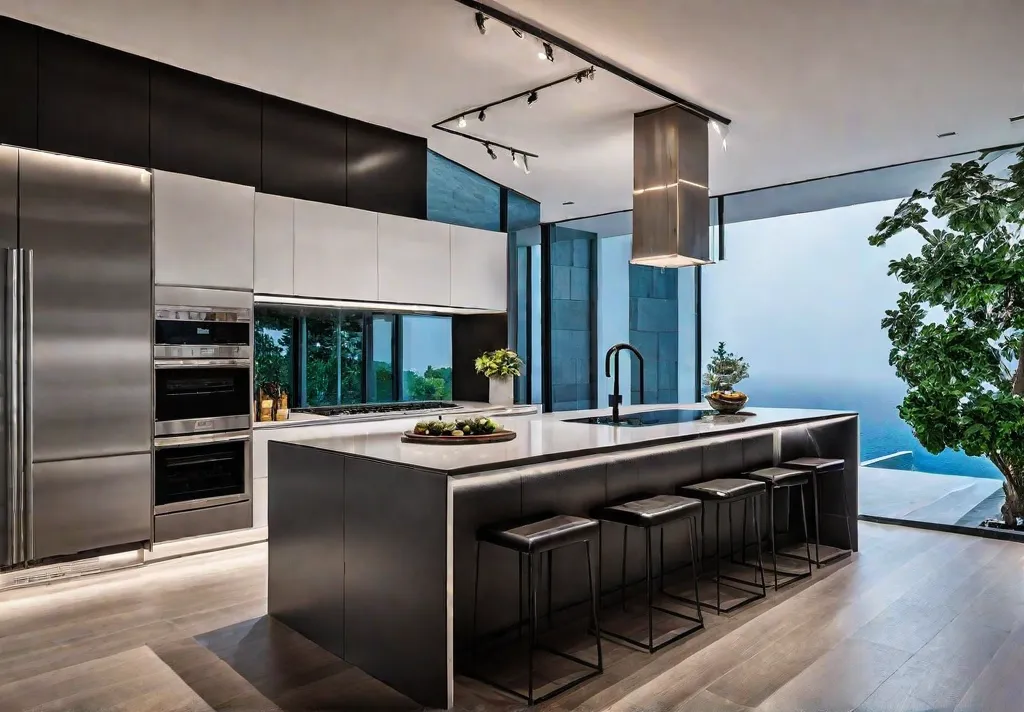Have you ever walked into a friend's kitchen and felt like you entered the future? With smart appliances, sustainable materials, and flexible layouts, modern kitchens are transforming into hubs of innovation and style. As a home and garden specialist, I've been fascinated by the rapid evolution of kitchen design. In this article, we'll explore the latest trends and cutting-edge technologies that are redefining the heart of the home.
Imagine a kitchen where your voice commands the oven to preheat, your fridge tracks expiration dates, and your countertops seamlessly transition from meal prep to family gathering. Does this sound like something out of a sci-fi movie? Think again—this is the reality of modern kitchen design.
From eco-friendly features to personalized experiences, kitchens' future is about enhancing convenience, sustainability, and style. Whether planning a renovation or simply curious about the latest innovations, join me as we dive into the exciting world of modern kitchen design.
Smart Home Technology
Integrating smart home technology is revolutionizing how we interact with our kitchens. Imagine controlling your appliances, adjusting the lighting, and monitoring energy usage, all with a simple voice command. This level of convenience and connectivity is becoming increasingly common in modern kitchens.
Smart appliances like voice-controlled ovens and app-enabled refrigerators are leading the charge. These devices can make your life easier and help you save energy and reduce waste. For example, a smart fridge that can track expiration dates and create shopping lists takes the guesswork out of meal planning.

According to a report by MarketsandMarkets, the global smart home market is expected to grow from $41 billion in 2020 to $71 billion by 2025. The kitchen is a significant growth area as homeowners increasingly seek ways to streamline their cooking and cleaning routines.
Consider investing in voice assistants like Amazon Alexa or Google Assistant to bring smart technology into your kitchen. These devices can control your lights, set timers, and even preheat your oven with a simple voice command. You can also explore app-enabled appliances that allow you to monitor and adjust settings from your smartphone, even when you're not at home.
Sustainable and Eco-Friendly Design
As environmental concerns become more pressing, sustainable design is taking center stage in modern kitchens. Homeowners increasingly prioritize eco-friendly features that reduce their carbon footprint and promote a healthier living environment.
One key aspect of sustainable kitchen design is the use of energy-efficient appliances. Look for the Energy Star certification, which indicates that an appliance meets strict energy efficiency guidelines set by the U.S. Environmental Protection Agency. Induction cooktops, for example, are more energy-efficient than traditional gas or electric stoves, as they only heat the cookware directly.
Beyond appliances, sustainable kitchen design also uses renewable and recycled materials. Bamboo cabinetry, recycled glass countertops, and reclaimed wood accents are becoming popular choices. These materials reduce environmental impact and add a unique, artisanal touch to the space.

Water conservation is another important consideration in modern kitchen design. Low-flow faucets and water-efficient dishwashers can help reduce water consumption, while composting systems and recycling solutions can minimize food waste [4,5].
As the global market for sustainable kitchen products is expected to reach $5 billion by 2025, it's clear that eco-friendly design is no longer just a trend - it's a necessity. By incorporating these sustainable features into your kitchen, you can create a space that is not only beautiful but also environmentally responsible.
Multifunctional and Flexible Spaces
The modern kitchen is evolving to become a more versatile and adaptable space, catering to homeowners' changing needs and lifestyles. With the rise of remote work and increased time spent at home, kitchen design is adapting to accommodate these new realities.
One key aspect of this trend is the open-concept layout. Homeowners can enjoy a more spacious and interactive environment by removing walls and creating a seamless flow between the kitchen and other living areas. This is particularly beneficial for families who want to stay connected while cooking, dining, and entertaining.
Multipurpose kitchen islands are another hallmark of modern, flexible design. These islands can transition from food preparation to dining and socializing, with built-in seating, storage, and even appliances. This allows the kitchen to be a true hub for the entire household.

Convertible furniture, such as dining tables that can be transformed into workstations, also contributes to the multifunctional nature of modern kitchens. By incorporating adaptable elements, homeowners can ensure that their kitchen space remains relevant and useful as their needs evolve.
A recent survey found that 65% of homeowners consider a flexible and multifunctional kitchen layout a top priority when renovating or building a new home. This trend reflects the growing demand for kitchens that seamlessly integrate with other living areas, creating a cohesive and connected living experience.
Personalization and Customization
As homeowners increasingly seek to create unique and tailored environments, the demand for personalized and customized kitchen spaces is rising. Modern kitchen design is all about self-expression and individuality, from bespoke cabinetry to custom-designed islands.
Bespoke cabinetry is a key aspect of this trend, allowing homeowners to create a one-of-a-kind look and feel for their kitchen. By working with a designer or carpenter, you can choose from various materials, finishes, and styles to ensure that your cabinetry reflects your aesthetic.
Custom-designed kitchen islands are another way to personalize your space. These islands can be tailored to your specific needs, with features like built-in sinks, cooktops, or storage solutions. They can also complement your kitchen's overall style, creating a cohesive and visually stunning space.

Personalized color schemes are another way to make your kitchen truly your own. Whether you opt for bold and vibrant hues or soft, muted tones, the right color palette can transform your kitchen's entire look and feel.
A recent study found that 82% of homeowners consider personalization a key factor when planning a kitchen renovation. This trend reflects the growing desire for self-expression and the creation of truly unique living spaces.
To incorporate personalization into your kitchen design, consider investing in custom cabinetry, a one-of-a-kind island, or a bold backsplash that showcases your style. You can also explore integrating smart technology, such as touch-screen control panels or voice-activated assistants, to create a more personalized and interactive cooking experience.
Wellness-Focused Kitchens
The modern kitchen is evolving to prioritize touchscreen wellness, with features and design elements that promote mindful living, nutrition, and overall well-being. This trend is gaining momentum as homeowners become more conscious of their environmental impact and the importance of healthy living.

One key aspect of wellness-focused kitchen design is integrating smart technology for nutrition tracking. Smart refrigerators, for example, can provide nutritional information about the food stored within, while smart ovens can suggest healthy recipes based on the available ingredients. This technology can help homeowners make more informed choices about their diet and promote more nutritious eating habits.
Air purification systems are another important feature in wellness-focused kitchens. These systems can help remove pollutants and allergens from the air, creating a healthier environment for cooking and dining. This is particularly beneficial for individuals with respiratory issues or allergies.
Ergonomic design is also a crucial element of wellness-focused kitchens. By incorporating features like adjustable countertops and pull-out shelves, kitchen design can reduce strain on the body during food preparation, promoting a more comfortable and efficient cooking experience.
Biophilic design incorporates natural elements into interior spaces and is also becoming more prevalent in modern kitchens. The use of natural materials like wood and stone, as well as the inclusion of plants and natural light, can create a calming and restorative atmosphere that supports overall well-being.

A recent survey found that 73% of homeowners prioritize healthy living when planning a kitchen renovation. This trend reflects the growing importance of creating living spaces that support physical and mental well-being.
By incorporating smart technology, air purification systems, ergonomic design, and biophilic elements, homeowners can transform their kitchens into wellness-focused havens that nourish both body and mind.
Multisensory Experiences
The modern kitchen is becoming a multisensory experience, with design elements that engage the senses and create a more immersive and memorable environment. Kitchen design is evolving from integrated lighting and sound systems to interactive display technologies to provide a truly sensory-rich experience.
Imagine a kitchen where the lighting adjusts to set the mood, whether you're hosting a dinner party or preparing a quick meal. Soft, ambient lighting can create a calming atmosphere, while brighter, task-oriented lighting can help you focus on the task. Integrated sound systems can also play a role, with soothing background music or energizing playlists to enhance the overall ambiance.

Beyond lighting and sound, interactive display technologies are also transforming the kitchen experience. Touchscreen control panels and voice-activated assistants allow homeowners to control various aspects of their kitchen, from temperature and appliance settings to recipe suggestions and meal planning.
Using natural materials and textures is crucial in creating a multisensory kitchen environment. The tactile experience of running your hands over a wooden cutting board or a stone countertop can add warmth and depth to the space, engaging your sense of touch and evoking a more visceral connection to the kitchen.
According to a recent study, 68% of homeowners consider the sensory experience of a kitchen a key factor in their design preferences. This trend reflects the growing desire for living spaces that look beautiful and feel inviting and engaging to the senses.

By incorporating integrated lighting and sound systems, interactive display technologies, and natural materials, kitchen designers can create a multisensory experience that captivates and delights the homeowner.
Blended Indoor-Outdoor Living
The boundaries between indoor and outdoor living are blurring, with modern kitchens seamlessly integrating with outdoor spaces to create a cohesive and connected living experience. This trend is becoming increasingly popular, with a recent survey indicating that 72% of homeowners consider integrating indoor and outdoor living spaces a top priority when planning a kitchen renovation.
Retractable walls and sliding doors are key in this trend, allowing for easy transition between the kitchen and outdoor living areas. These features create a seamless flow, enabling homeowners to move effortlessly between indoor cooking and dining and outdoor entertaining and relaxation.

To complement this indoor-outdoor integration, kitchen designers also incorporate appliances and furnishings specifically designed for use in both environments. Weather-resistant grills, outdoor refrigerators, and durable patio furniture can all contribute to a cohesive and functional indoor-outdoor kitchen space.
Blending the boundaries between the kitchen and the great outdoors allows homeowners to create a truly immersive and connected living experience. This trend not only enhances the kitchen's aesthetic appeal but also encourages a more active and engaged lifestyle, as homeowners can easily transition between cooking, dining, and entertaining indoors and out.
Conclusion
The future of modern kitchens is a captivating blend of innovative technologies, sustainable design practices, and evolving lifestyle trends. From smart home integration and eco-friendly features to multifunctional spaces and personalized experiences, the modern kitchen is poised to become an even more central and versatile home hub.

As homeowners continue to seek out unique and tailored kitchen environments that cater to their individual needs and preferences, the industry will respond with cutting-edge solutions and design concepts that redefine the way we interact with and experience our kitchen spaces.
Whether you're planning a kitchen renovation or simply curious about the latest trends, I hope this article has given you a glimpse into the exciting world of modern kitchen design. By embracing the innovations and trends shaping the kitchen's future, you can create a space that not only looks beautiful but also enhances your daily life and environmental footprint.
So, what are you waiting for? Start exploring the possibilities and get ready to transform your kitchen into a hub of innovation, sustainability, and personalized style.

